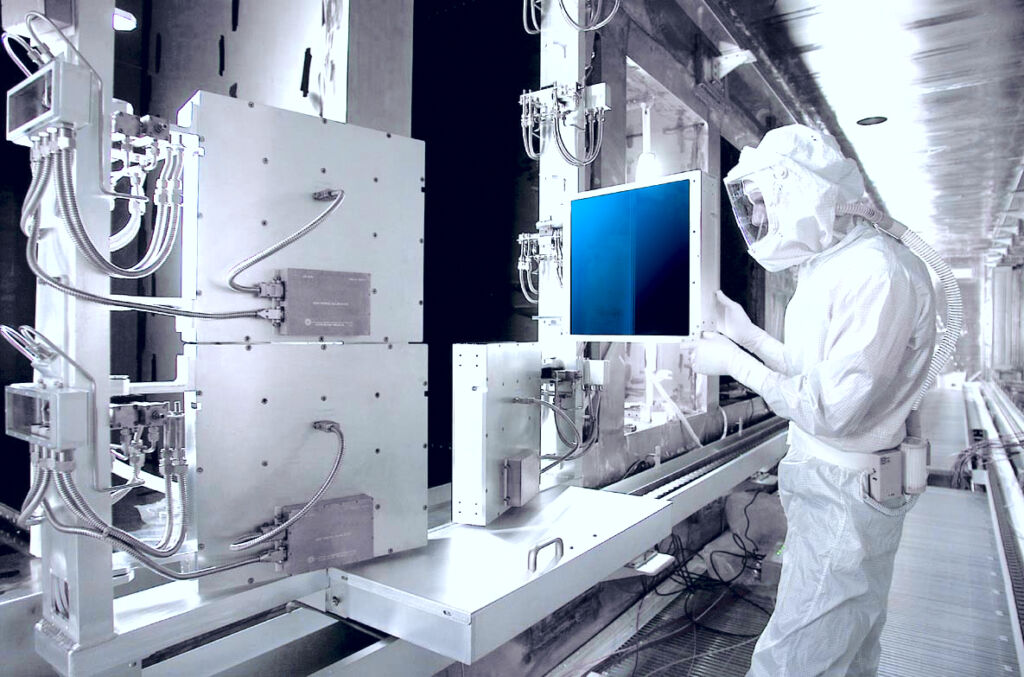Begin your exploration of calorimeters and calorimetry with our detailed guide, featuring a deep dive from essential basics to sophisticated applications in heat measurement. Navigate through the table of contents to discover more.
Table of Contents
- Introduction
- Historical Background
- Types of Calorimeters
- Principles of Calorimetry
- Practical Guide to Using Calorimeters
- Advanced Applications of Calorimetry
- Maintenance, Troubleshooting, and Safety
- Future Directions and Innovations in Calorimetry
- Conclusion
- Additional Resources

Inside the Clean Room: Harnessing Laser Calorimetry for Advanced Energy Measurements. Image courtesy of Gentec EO.
This technical guide on Calorimeters is brought to you by Gentec-EO - specializing in laser beam and THz source measurement and analysis
1. Introduction
Calorimeters, Explained: These devices measure heat exchange accurately, crucial for analyzing energy transformations in scientific research.
Why They Matter: These instruments are pivotal, linking theory with empirical evidence across varied fields, enriching our understanding and application of energy principles.
Broad Spectrum of Uses: The versatility of calorimeters stretches across disciplines, each leveraging their unique capabilities to shed light on complex phenomena:
- In Chemistry: They unravel the thermal narratives of reactions, essential for advancing thermochemistry.
- Physics: Calorimeters dissect substances’ thermal properties, crucial during phase transitions.
- Biological Insights: They quantify the energy flux in biological processes, vital for understanding metabolic and enzymatic pathways.
- Engineering Applications: In assessing materials and refining energy systems, calorimeters prove indispensable.
- Food Science Investigations: They provide key data on nutritional content and stability, influencing food quality and safety standards.
In each of these applications, calorimeters not only answer fundamental questions but also drive innovation and efficiency in both research and industry.
2. Historical Background of Calorimeters
The journey of calorimetry from its inception involves transitioning from elementary experiments, such as melting ice to gauge heat absorption, to the creation of intricate devices capable of detecting minuscule heat variations with remarkable precision. The following are the major milestones achieved in this journey and the key people who have contributed significantly.
Major Milestones:
- 18th Century Foundations: The advent of calorimetry can be traced back to Antoine Lavoisier and Pierre-Simon Laplace’s ice calorimeter, a revolutionary device of its time that provided a method to quantify heat generated from chemical reactions.
- 19th Century Advancements: The invention of the bomb calorimeter brought a significant leap in measuring the heat of combustion with greater accuracy, becoming a staple in chemical and energy-related research.
- 20th Century Innovations: The emergence of differential scanning calorimetry (DSC) in the mid-20th century transformed material science, offering a nuanced view of heat flow in relation to temperature changes, thus broadening the scope of calorimetric analysis.
Key Figures:

Antoine Lavoisier (1743 – 1794), Father of Modern Chemistry
Antoine Lavoisier, renowned as the “father of modern chemistry,” made pivotal contributions to the field of calorimetry. His innovative approach and experiments were crucial in establishing the fundamental principles of thermal analysis, which laid the groundwork for understanding heat and energy transformations in chemical reactions.

Pierre-Simon Laplace (1749 – 1827), Developer of ice calorimeter
Pierre-Simon Laplace, working alongside Lavoisier, significantly contributed to calorimetry by co-developing the ice calorimeter. This collaboration led to a more refined method for measuring heat, enhancing the precision and reliability of thermal experiments.

Gustav Heinrich Johann Apollon Tammann (1861 – 1938), Pioneer of differential thermal analysis
Gustav Heinrich Johann Apollon Tammann‘s pioneering work in differential thermal analysis was foundational in shaping modern calorimetry. His research introduced methods that significantly improved the analytical capabilities of calorimeters, pushing the field towards more sophisticated and nuanced analysis techniques.
3. Types of Calorimeters
To dive deeper into the world of calorimeters, let’s look into the various types and their specific applications. This includes Differential Scanning Calorimeters (DSC) commonly used in material science, Bomb Calorimeters essential for measuring the calorific value of substances, Isothermal Titration Calorimeters (ITC) which play a crucial role in biochemistry for studying molecular interactions, Adiabatic Calorimeters used for studying reactions under controlled conditions, and High-Energy Laser Calorimeters, designed for precision measurement in high-energy laser applications. Each type has its unique features and use cases, catering to a wide range of scientific and industrial needs.
Differential Scanning Calorimeters (DSC)
Differential Scanning Calorimeters (DSC) are pivotal in material science for analyzing how a material’s heat capacity changes with temperature. DSC can identify phase transitions like melting, crystallization, and glass transitions by measuring the heat flow into or out of a sample compared to a reference. This makes DSC an indispensable tool for studying polymers, pharmaceuticals, and metals, providing insights into material properties and behavior under varying thermal conditions.
DSC works by heating a sample and a reference material at the same rate and measuring the heat flow required to maintain both at the same temperature. When the sample undergoes a phase transition, it either absorbs or releases heat, leading to a difference in heat flow between the sample and reference. This difference is recorded as a peak on a DSC curve, providing insights into the thermal properties and transitions of the material.
Bomb Calorimeters
Bomb Calorimeters are essential in quantifying the heat of combustion for various substances. This device consists of a sealed chamber, the “bomb,” where the sample is ignited in an oxygen-rich environment to ensure complete combustion. The bomb is submerged in a water-filled jacket, and the temperature rise in the water is precisely measured to calculate the energy content of the sample. This technique is widely used in fuel analysis, food industry to determine caloric content, and in material testing to evaluate energy-releasing reactions.
Isothermal Titration Calorimeters (ITC)
Isothermal Titration Calorimetry (ITC) is a powerful technique for studying molecular interactions in real-time, without the need for labeling. It measures the heat released or absorbed during binding events, providing detailed information on the thermodynamics of the interaction, including binding constants, enthalpy changes, and stoichiometry. ITC is widely used in biochemistry and pharmaceutical research to understand how drugs interact with their targets, aiding in the design of more effective therapeutics.
Adiabatic Calorimeters
Adiabatic Calorimeters are designed to measure heat reactions without heat exchange with the surroundings, making them ideal for studying exothermic reactions and thermal stability. In this setup, the sample is insulated to ensure that all heat generated from the reaction remains within the system. This method is crucial in safety testing and chemical process design, providing insights into reaction kinetics and potential hazards, such as thermal runaway, in chemical manufacturing and storage.
High-Energy Laser Calorimeters
High-Energy Laser Calorimeters are specialized for measuring the energy of high-power laser beams, crucial in fields like laser physics and optical research. They provide precision in environments where laser intensity and energy must be accurately quantified, such as in laser fusion experiments or when evaluating the performance of high-power laser systems. These calorimeters are tailored to handle the extreme conditions of high-energy lasers, ensuring reliable and accurate measurements essential for advancing laser technology and applications.
4. Principles of Calorimetry
Calorimetry principles revolve around measuring the heat involved in chemical reactions or physical changes. This process leans heavily on the first law of thermodynamics, which states that energy cannot be created or destroyed, only transferred or transformed. Calorimeters measure this energy transfer as heat, which can indicate various thermodynamic properties such as heat capacity and enthalpy changes. Heat capacity is a measure of a substance’s ability to absorb heat, leading to a temperature change. Enthalpy changes, on the other hand, involve heat exchange at constant pressure, critical for understanding reactions.
Expanding on the principles of calorimetry with an example, consider a simple reaction where a substance dissolves in water, causing a temperature change. Using a calorimeter, one could measure the initial and final temperatures of the solution to determine the heat absorbed or released during dissolution. This heat change, when related to the mass of the substance, can reveal the substance’s heat capacity, providing insights into its thermodynamic behavior. This foundational principle of measuring heat changes during physical or chemical processes underlies all types of calorimeters, regardless of their specific design or application area.
5. Practical Guide to Using Calorimeters
A comprehensive guide to using calorimeters involves meticulous attention to setup, sample preparation, data collection, and the subsequent analysis and interpretation of the data:
- Setup and Calibration: Begin by properly setting up the calorimeter according to the manufacturer’s instructions, ensuring all components are correctly assembled and the device is functioning as intended. Calibration is crucial and typically involves using standard materials with known heat capacities to adjust the calorimeter’s readings for accuracy.
- Sample Preparation and Handling: The integrity of your sample is paramount. Prepare your samples in a controlled environment to prevent contamination or loss. For substances prone to reaction or degradation, take additional precautions to maintain their stability until measurement.
- Data Collection: During the experiment, closely monitor the calorimeter’s readings. Consistent data recording is essential, as is noting any anomalies or deviations in the expected results, which could indicate experimental errors or new phenomena.
- Analysis and Interpretation: After collecting data, analyze the results in the context of the experiment’s objectives. Look for patterns or trends that can provide insights into the thermal properties or reactions under study. Interpretation should consider the broader scientific principles at play, integrating the findings with existing knowledge in the field.
Throughout these steps, maintaining rigorous scientific methodology and a keen attention to detail will ensure the reliability and relevance of the calorimetric analysis.
6. Advanced Applications of Calorimetry
Calorimetry, a versatile tool in scientific research, finds its application across diverse fields, each harnessing its principles to unravel complex phenomena:
In chemistry, calorimetry serves as a window into the energetic landscape of chemical reactions and phase transitions. It allows scientists to quantify the heat involved in these processes, providing a deeper understanding of molecular interactions and stability.
Transitioning to biology, calorimetry’s role is equally pivotal. It offers a non-invasive method to study biological processes, such as enzyme-catalyzed reactions, by measuring the subtle heat changes associated with metabolic activities. This insight is invaluable in deciphering the intricate mechanisms of life at a molecular level.
In material science and engineering, calorimetry aids in characterizing the thermal properties of materials. This information is crucial for developing new materials with desired thermal behaviors, impacting everything from aerospace to consumer electronics.
Furthermore, environmental science and renewable energy research benefit from calorimetry’s ability to assess the energy content of biofuels and the metabolic activity in soils. Such applications are essential for advancing sustainable practices and exploring alternative energy sources.
7. Maintenance, Troubleshooting, and Safety of Calorimeters
To ensure the accuracy and longevity of your calorimeter, a comprehensive approach to maintenance, troubleshooting, and safety is essential.
Maintenance: Regular upkeep is vital. This includes periodic sensor accuracy checks to ensure precise readings, thorough cleaning of all components to prevent contamination, and software updates to keep the system running smoothly.
Troubleshooting: Familiarize yourself with common issues such as calibration drifts or sensor failures. Swiftly addressing these problems often requires consulting the manufacturer’s troubleshooting guides or seeking expert assistance to prevent prolonged downtime.
Safety: Prioritize safety by wearing the appropriate protective gear, especially when dealing with hazardous materials. Understand the risks associated with the substances you’re measuring and follow established safety protocols to mitigate potential dangers.
Adhering to these guidelines not only extends the lifespan of your calorimeter but also guarantees consistent, reliable results, ensuring the safety of the user and integrity of the data collected.
8. Future Directions and Innovations in Calorimetry
The field of calorimetry is on the cusp of significant advancements, driven by both technological innovations and the exploration of new research domains. Innovations are focusing on enhancing the sensitivity and accuracy of calorimeters, allowing for the analysis of increasingly smaller sample sizes, which is crucial for rare or expensive materials. This progress is paving the way for novel applications such as nano-scale calorimetry, offering unprecedented insights into the thermal properties at the nanometer scale.
Additionally, the integration of calorimetry with other analytical techniques is opening up new avenues in real-time monitoring of complex biochemical and physical processes. The future of calorimetry looks promising, with potential to revolutionize fields like renewable energy, environmental science, and personalized medicine, further solidifying its role as a fundamental tool in both research and industry.
9. Conclusion
To sum up, in this guide we have traversed the expansive terrain of calorimetry, illuminating its fundamental principles, diverse applications, and the cutting-edge innovations shaping its future. From its historical origins to the latest advancements, we’ve seen how calorimetry serves as a critical bridge between theoretical energy concepts and their practical implications across various fields. As we look forward, the evolving landscape of calorimetry promises to unlock new discoveries and innovation. Whether it’s through the refinement of existing techniques or the exploration of uncharted territories in nanoscale thermal analysis, the journey of calorimetry is far from complete. Its continued evolution will undoubtedly contribute to groundbreaking advancements in science and technology, reaffirming its indispensable role in understanding and harnessing the complexities of energy transformation.
If you liked this article you might also like our Guide on Lux Meters and our Guide on Laser Power Meters.
10. Additional Resources on Calorimeters
For those looking to deepen their understanding of calorimetry and explore more resources, the following materials and avenues can provide valuable information and opportunities for further learning and professional engagement:
Recommended Readings and Textbooks
- “Principles of Thermal Analysis and Calorimetry“ by Simon Gaisford and Peter Haines: This textbook provides a comprehensive overview of the theoretical foundations of calorimetry and practical applications in various scientific disciplines.
- “Calorimetry: Fundamentals, Instrumentation and Applications” by Stefan Mathias Sarge and Gerhard Höhne: A detailed exploration of calorimetric principles, instrumentation, and its wide-ranging applications, making it a valuable resource for both beginners and experienced researchers.
- “Thermal Analysis of Polymers: Fundamentals and Applications“ by Joseph D. Menczel and R. Bruce Prime: Although focused on polymers, this book offers insights into the use of calorimetry within the field of thermal analysis, providing case studies and practical guidance.
Links to Online Tutorials and Instructional Videos
- MIT OpenCourseWare: The Massachusetts Institute of Technology offers free online course materials, including lectures on thermodynamics that cover calorimetry topics. (https://ocw.mit.edu)
- Khan Academy: Provides a range of free educational videos on various subjects, including physics and chemistry, with some covering the basics of calorimetry. (https://www.khanacademy.org)
- Chemistry LibreTexts: Offers comprehensive tutorials and guides on different chemistry topics, including a section on calorimetry that is suitable for learners at various levels. (https://chem.libretexts.org)
Professional Organizations and Conferences Related to Calorimetry
- The International Confederation for Thermal Analysis and Calorimetry (ICTAC): A global organization that brings together scientists and practitioners interested in thermal analysis and calorimetry, offering resources, networking opportunities, and conferences. (www.ictac.org)
- The North American Thermal Analysis Society (NATAS): Offers resources, educational opportunities, and annual conferences focused on thermal analysis and calorimetry in North America. (https://www.natasinfo.org)
These resources can serve as a springboard for further exploration into the world of calorimetry, offering a blend of foundational knowledge, advanced insights, and professional community engagement to support both novices and experts in the field.
